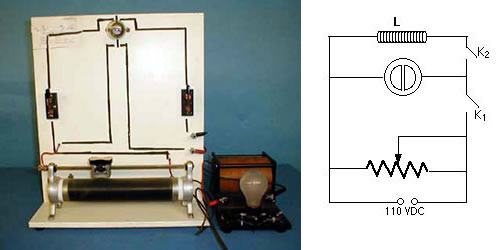Demos: 6D-10 Self-Induction

A neon lamp with circular electrodes is connected to a 110 V DC supply through a rheostat and a switch K1. A low-resistance, high self-inductance coil is connected parallel with the lamp through switch K2. With K2 open and K1 closed, the cathode of the neon lamp lights up when the voltage across the bulb is 80 V or greater, and stays lit. If K2 is then closed, the light goes out because L has a low resistance. But on opening or closing K1, the cathode or anode will glow momentarily, because of the emf induced in L following Lenz’s Law.
Directions: The circuit should be set up ahead of time by the lec-demo staff. Close the key K1 to cause the neon bulb to glow. Then close K2. Noting the bulb has now gone out, open K1. After noting that the bulb momentarily lit, close K1 to note that it lights again.
Suggestions for Presentation: Briefly describe the operation of the neon bulb, particularly in regard to its threshold voltage. Then remind the students that a coil has a fairly low DC resistance, so that when it is placed in parallel with the bulb, there is almost a direct short of the bulb. After opening and closing K1, have the students speculate as to how the voltage across the bulb could suddenly rise to the threshold and why different halves of the bulb light, respectively.
Applications:
Last Updated: Nov 30, 2023 11:25 AM